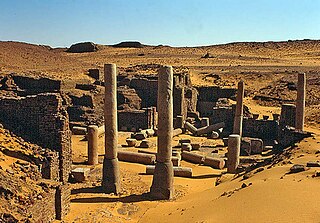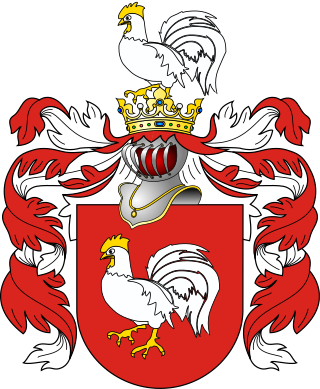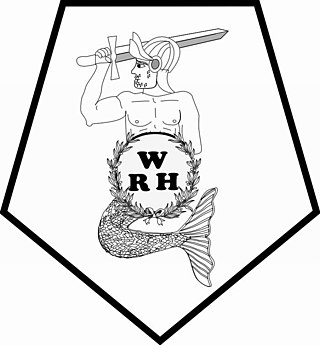
The Adam Mickiewicz University is a research university in Poznań, Poland. Due to its history, the university is traditionally considered among Poland's most reputable institutions of higher learning, this standing equally being reflected in national rankings.

Old Dongola is a deserted Nubian town in what is now Northern State, Sudan, located on the east bank of the Nile opposite the Wadi Howar. An important city in medieval Nubia, and the departure point for caravans west to Darfur and Kordofan, from the fourth to the fourteenth century Old Dongola was the capital of the Makurian state. A Polish archaeological team has been excavating the town since 1964.

Jadwiga Falkowska codename: Jaga, Zdzisława, Ludwika, Zaleska was a Polish teacher, physicist, social activist, Scoutmaster (harcmistrzyni) and one of the founders of Girl Scouting in Poland.

Faras was a major city in Lower Nubia. The site of the city, on the border between modern Egypt and Sudan at Wadi Halfa Salient, was flooded by Lake Nasser in the 1960s and is now permanently underwater. Before this flooding, extensive archaeological work was conducted by a Polish archaeological team led by professor Kazimierz Michałowski.

The University of Warsaw is a public research university in Warsaw, Poland. Established on November 19, 1816, it is the largest institution of higher learning in the country, offering 37 different fields of study as well as 100 specializations in humanities, technical, and natural sciences.

Kur is a Polish coat of arms. It was used by several noble families forming a Clan of Kur in the times of the Kingdom of Poland and the Polish–Lithuanian Commonwealth. It is noted during the reign of the Jagiellon dynasty and illustrated with its original name in the work of Bartosz Paprocki "Herby Rycerstwa Polskiego" in 1584. Furthermore, it is published in the work of Szymon Okolski in 1641. and several other publications

Antoni Bolesław Dobrowolski was a Polish geophysicist, meteorologist and explorer.

Władysław Witwicki was a Polish psychologist, philosopher, translator, historian and artist. He is seen as one of the fathers of psychology in Poland.
Krzysztof Boruń was a Polish physicist, journalist and science fiction writer. As an author of a number of essays, articles and novels, he was an important popularizer of science. By his contemporaries, Boruń was described as the "visionary of space travel"

The Warsaw Homosexual Movement was an independent group of gays and lesbians which existed in Warsaw between January 1987 and summer 1988. The government of the Polish People's Republic refused the group's registration to become an NGO.

Krzysztof Bogdan Garwatowski, is a Polish LGBT activist, journalist and publisher of porn magazines.

Stanisław Krajewski is a Polish philosopher, mathematician and writer, activist of the Jewish minority in Poland.
Bogusław Wolniewicz was a Polish philosopher. He was a professor at University of Warsaw from 1963 to 1998. In scholarly circles, he is known as a translator and commentator of Ludwig Wittgenstein. From the 1990s, he became a publicist mostly affiliated with the Radio Maryja community. His controversial views were often regarded as anti-Semitic and Islamophobic.
The Polish Physical Society is a professional scientific society of Polish physicists.

Piotr Kraśko is a Polish journalist, theatrologist and television presenter. Between 1991 and 2016 he worked for the Telewizja Polska and since 2016 for the TVN channel.

Krzysztof Gawędzki was a Polish mathematical physicist, a graduate of the University of Warsaw and professor at the École normale supérieure de Lyon. He was primarily known for his research on quantum field theory and statistical physics. In 2022, he shared the Dannie Heineman Prize for Mathematical Physics with Antti Kupiainen.
Anna Maria Zdunik is a Polish mathematician. She specializes in dynamical systems, and is a professor at the University of Warsaw.
The Anna reactor was a Polish research nuclear reactor of graphite-water design. Construction began in 1961 in a dedicated building in the Institute for Nuclear Research in Otwock near Warsaw. The Anna reactor was commissioned on June 12, 1963, thus becoming the second and eventually the third most powerful nuclear reactor in Poland.

Krzysztof Edward Haman is a Polish atmospheric physicist, professor at the University of Warsaw, and member of the Polish Academy of Sciences.

The Astronomical Observatory University of Warsaw is an institute that conducts astronomical research and teaching in astronomy. It is a part of Faculty of Physics University of Warsaw. The Observatory provides astronomy classes for BSc, MSc, and PhD students. Student telescope activities take place at the observing station in Ostrowik. The scientific research is conducted in a wide range of topics. Two main observing projects are long-term sky surveys: OGLE and ASAS. Both surveys take data using dedicated telescopes located at the Las Campanas Observatory, Chile. Scientific staff takes part in large astrophysical collaborations, both ground-based and satellite.















